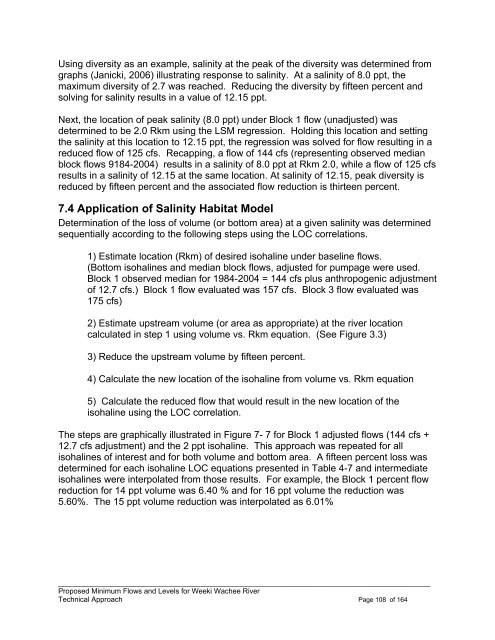Weeki Wachee River System Recommended Minimum Flows and ...
Weeki Wachee River System Recommended Minimum Flows and ...
Weeki Wachee River System Recommended Minimum Flows and ...
Create successful ePaper yourself
Turn your PDF publications into a flip-book with our unique Google optimized e-Paper software.
Using diversity as an example, salinity at the peak of the diversity was determined from<br />
graphs (Janicki, 2006) illustrating response to salinity. At a salinity of 8.0 ppt, the<br />
maximum diversity of 2.7 was reached. Reducing the diversity by fifteen percent <strong>and</strong><br />
solving for salinity results in a value of 12.15 ppt.<br />
Next, the location of peak salinity (8.0 ppt) under Block 1 flow (unadjusted) was<br />
determined to be 2.0 Rkm using the LSM regression. Holding this location <strong>and</strong> setting<br />
the salinity at this location to 12.15 ppt, the regression was solved for flow resulting in a<br />
reduced flow of 125 cfs. Recapping, a flow of 144 cfs (representing observed median<br />
block flows 9184-2004) results in a salinity of 8.0 ppt at Rkm 2.0, while a flow of 125 cfs<br />
results in a salinity of 12.15 at the same location. At salinity of 12.15, peak diversity is<br />
reduced by fifteen percent <strong>and</strong> the associated flow reduction is thirteen percent.<br />
7.4 Application of Salinity Habitat Model<br />
Determination of the loss of volume (or bottom area) at a given salinity was determined<br />
sequentially according to the following steps using the LOC correlations.<br />
1) Estimate location (Rkm) of desired isohaline under baseline flows.<br />
(Bottom isohalines <strong>and</strong> median block flows, adjusted for pumpage were used.<br />
Block 1 observed median for 1984-2004 = 144 cfs plus anthropogenic adjustment<br />
of 12.7 cfs.) Block 1 flow evaluated was 157 cfs. Block 3 flow evaluated was<br />
175 cfs)<br />
2) Estimate upstream volume (or area as appropriate) at the river location<br />
calculated in step 1 using volume vs. Rkm equation. (See Figure 3.3)<br />
3) Reduce the upstream volume by fifteen percent.<br />
4) Calculate the new location of the isohaline from volume vs. Rkm equation<br />
5) Calculate the reduced flow that would result in the new location of the<br />
isohaline using the LOC correlation.<br />
The steps are graphically illustrated in Figure 7- 7 for Block 1 adjusted flows (144 cfs +<br />
12.7 cfs adjustment) <strong>and</strong> the 2 ppt isohaline. This approach was repeated for all<br />
isohalines of interest <strong>and</strong> for both volume <strong>and</strong> bottom area. A fifteen percent loss was<br />
determined for each isohaline LOC equations presented in Table 4-7 <strong>and</strong> intermediate<br />
isohalines were interpolated from those results. For example, the Block 1 percent flow<br />
reduction for 14 ppt volume was 6.40 % <strong>and</strong> for 16 ppt volume the reduction was<br />
5.60%. The 15 ppt volume reduction was interpolated as 6.01%<br />
____________________________________________________________________________________________<br />
Proposed <strong>Minimum</strong> <strong>Flows</strong> <strong>and</strong> Levels for <strong>Weeki</strong> <strong>Wachee</strong> <strong>River</strong><br />
Technical Approach Page 108 of 164
















